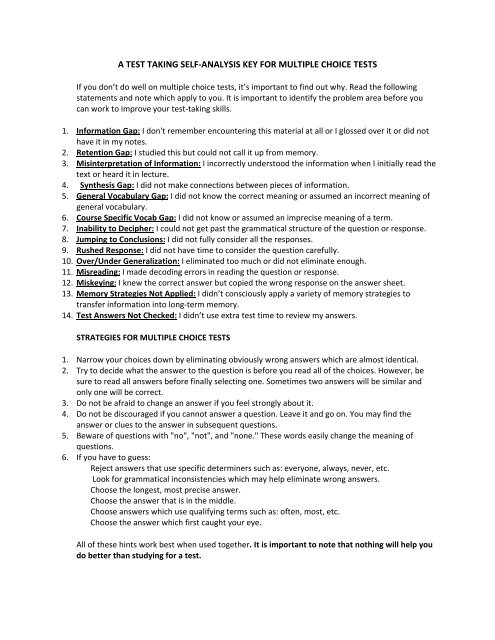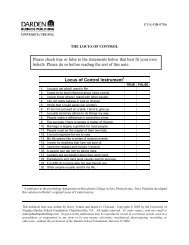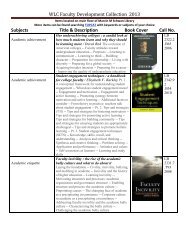A TEST TAKING SELF-ANALYSIS KEY FOR MULTIPLE CHOICE ...
A TEST TAKING SELF-ANALYSIS KEY FOR MULTIPLE CHOICE ...
A TEST TAKING SELF-ANALYSIS KEY FOR MULTIPLE CHOICE ...
You also want an ePaper? Increase the reach of your titles
YUMPU automatically turns print PDFs into web optimized ePapers that Google loves.
A <strong>TEST</strong> <strong>TAKING</strong> <strong>SELF</strong>‐<strong>ANALYSIS</strong> <strong>KEY</strong> <strong>FOR</strong> <strong>MULTIPLE</strong> <strong>CHOICE</strong> <strong>TEST</strong>S<br />
If you don’t do well on multiple choice tests, it’s important to find out why. Read the following<br />
statements and note which apply to you. It is important to identify the problem area before you<br />
can work to improve your test‐taking skills.<br />
1. Information Gap: I don't remember encountering this material at all or I glossed over it or did not<br />
have it in my notes.<br />
2. Retention Gap: I studied this but could not call it up from memory.<br />
3. Misinterpretation of Information: I incorrectly understood the information when I initially read the<br />
text or heard it in lecture.<br />
4. Synthesis Gap: I did not make connections between pieces of information.<br />
5. General Vocabulary Gap: I did not know the correct meaning or assumed an incorrect meaning of<br />
general vocabulary.<br />
6. Course Specific Vocab Gap: I did not know or assumed an imprecise meaning of a term.<br />
7. Inability to Decipher: I could not get past the grammatical structure of the question or response.<br />
8. Jumping to Conclusions: I did not fully consider all the responses.<br />
9. Rushed Response: I did not have time to consider the question carefully.<br />
10. Over/Under Generalization: I eliminated too much or did not eliminate enough.<br />
11. Misreading: I made decoding errors in reading the question or response.<br />
12. Miskeying: I knew the correct answer but copied the wrong response on the answer sheet.<br />
13. Memory Strategies Not Applied: I didn’t consciously apply a variety of memory strategies to<br />
transfer information into long‐term memory.<br />
14. Test Answers Not Checked: I didn’t use extra test time to review my answers.<br />
STRATEGIES <strong>FOR</strong> <strong>MULTIPLE</strong> <strong>CHOICE</strong> <strong>TEST</strong>S<br />
1. Narrow your choices down by eliminating obviously wrong answers which are almost identical.<br />
2. Try to decide what the answer to the question is before you read all of the choices. However, be<br />
sure to read all answers before finally selecting one. Sometimes two answers will be similar and<br />
only one will be correct.<br />
3. Do not be afraid to change an answer if you feel strongly about it.<br />
4. Do not be discouraged if you cannot answer a question. Leave it and go on. You may find the<br />
answer or clues to the answer in subsequent questions.<br />
5. Beware of questions with "no", "not", and "none." These words easily change the meaning of<br />
questions.<br />
6. If you have to guess:<br />
Reject answers that use specific determiners such as: everyone, always, never, etc.<br />
Look for grammatical inconsistencies which may help eliminate wrong answers.<br />
Choose the longest, most precise answer.<br />
Choose the answer that is in the middle.<br />
Choose answers which use qualifying terms such as: often, most, etc.<br />
Choose the answer which first caught your eye.<br />
All of these hints work best when used together. It is important to note that nothing will help you<br />
do better than studying for a test.
Three Pass Strategy:<br />
1. Round One : First read through the test . Cover up the possible answers and read only the stem of<br />
the question – look at the answers and if you are confident you know it, answer it. If you are not<br />
certain, place a “?” next to the question and move on to the next one.<br />
2. Round Two: On the Second pass through the test, concentrate on the questions that you placed a<br />
“?” next to. Eliminate the obviously wrong answers by crossing them out on the sheet. If you’ve<br />
eliminated the obviously wrong answers down to two, you now have a 50/50 chance.<br />
• Sometimes questions further down on the test will give you clues to previous questions; go<br />
back and change those as necessary.<br />
• Make certain to erase the “?” next to the questions you answer.<br />
• If you cannot come to a decision by reasoning, guess. But don’t erase the “?” next to guesses as<br />
you might be able to go back later and answer the question with certainty.<br />
• It is better to guess at an answer than to leave it blank. If you leave it blank you are certain to<br />
get it wrong.<br />
3. Round Three: In the final 5‐10 minutes go back over your test one more time, and double check the<br />
questions with a “?” next to them.<br />
Try taking a few breaks during the exam by stopping for a moment, shutting your eyes,<br />
and taking some deep breaths. Periodically clearing your head in this way can help you<br />
stay fresh during the exam session. Remember, you get no points for being the first person<br />
to finish the exam, so don't feel like you have to race through all the items -- even two or<br />
three 30-second breaks can be very helpful.<br />
Compiled from:<br />
http://www.softpanorama.org/Education/SAT/Strategy/multiple_choice_questions_exam_strategies.shtml





